NASA unplugs NEAR:
-Feb 28 2001:


Seismic activity releasing the underworld of Eros...
Impact-Induced Seismic Activity on Asteroid 433 Eros:
Eros is famous as the first asteroid to be orbited by a spacecraft, and as the first one on which a spacecraft landed. But it was important to astronomers as far back as 1898, when it became the first near-Earth asteroid (NEA) to be discovered.
https://solarsystem.nasa.gov/planets/433eros
NASA unplugged the "Seismic Impact" NEAR a few hours after the underworld "phoenix" rumble...
Seattle 'intraslab' quake began deep in Earth
A rumble from far below
Double dose of woe strikes historic Seattle neighborhood
Quake follows on heels of Mardi Gras riot






NEAR Shoemaker (Near Earth Asteroid Rendezvous)
NEAR Shoemaker is the first spacecraft mission specifically designed to study an asteroid. It was launched on February 17, 1996 on a four-year journey to the Near-Earth asteroid 433 Eros. Originally only named NEAR, the spacecraft was renamed after arriving at the asteroid, in honor of the late Eugene Shoemaker, a renowned planetary scientist.

The mission landed on Eros during the STS 98 Atlantis mission literally resonating Armageddon...
"DESTINI" (Deep Earth Seismic Trigger INItiative)

STS-98 was a 2001 Space Shuttle mission to the International Space Station (ISS) flown by Space Shuttle Atlantis. STS-98 delivered to the station the Destiny Laboratory Module. All mission objectives were completed and the shuttle reentered and landed safely at Edwards Air Force Base on 20 February 2001,[1][2] after twelve days in space, six of which were spent docked to the ISS.
Armageddon Atlantis Impact
STS 98 landed the same day OSIRIS was launched:
The main instrument on Odin is a radiometer using a 1.1 m telescope, designed to be used for both the astronomy and aeronomy missions. The radiometer works at 486–580 GHz and at 119 GHz. The second instrument on board is the OSIRIS (Optical Spectrograph and InfraRed Imager System).[3]Odin was developed by the Space Systems Division of Swedish Space Corporation (now OHB Sweden) as part of an international project involving the space agencies of Sweden (SNSB), Finland (TEKES), Canada (CSA) and France (CNES). Odin was launched on a START-1 rocket on February 20, 2001 from Svobodny, Russia.[4]
Deep Earth Seismic Trigger Feb 12 2001:
One observer noted Eros is symbolic of the monolith (2/12/01):
http://2p-encke.com/blog/2014/02/10/1-3-the-green-slime-is-n-e-a-r/Shoemaker being a lunar crater pointing to Jupiter ignition....
Eugene Merle Shoemaker (April 28, 1928 – July 18, 1997), also known as Gene Shoemaker, was an American geologist and one of the founders of the field of planetary science. He is best known for co-discovering the Comet Shoemaker–Levy 9 with his wife Carolyn S. Shoemaker and David H. Levy.
On July 31, 1999, some of his ashes were carried to the Moon by the Lunar Prospector space probe in a capsule designed by Carolyn Porco.[6][7] He is the only person whose ashes have been buried on any celestial body outside Earth.[8]
Lunar Prospector is the third mission selected by NASA for full development and construction as part of the Discovery Program. The probe also carried a small amount of the remains of Dr. Eugene Shoemaker (April 28, 1928 – July 18, 1997), astronomer and co-discoverer of Comet Shoemaker-Levy 9, to the Moon for a space burial.
Shoemaker is a lunar crater that is located near the southern pole of the Moon, within half a crater diameter of Shackleton. It lies to the south of the crater Malapert, to the east of Haworth, and just to the west of the similar-sized Faustini. The rim of Shoemaker is circular and worn, with some small craters along the inner wall. Due to the lack of illumination (it is a crater of eternal darkness), the albedo of the interior floor surface remains unknown.
Prior to being given its current name by the IAU, this formation had been informally named Mawson (after the Antarctic explorer Douglas Mawson). It was officially named Shoemaker in honor of Eugene Shoemaker, the geologist whose remains were on board the Lunar Prospector spacecraft that impacted this crater floor.
Monolith ash impact:

And the NEAR monolith/ash impact:

The launch of NEAR was also connected to deep impact:
The NEAR spacecraft was launched by the U.S. National Aeronautics and Space Administration on Feb. 17, 1996.
Intelsat 708 was a telecommunications satellite built by the American company Space Systems/Loral intended to be launched into a geostationary orbit and operated by Intelsat. It was destroyed during a launch failure on 15 February 1996, striking a village and causing a large number of fatalities near the Xichang Satellite Launch Center near Xichang, People's Republic of China, prompting political controversy around the world.

Feb.15: Long March rocket, with Intelsat 708 satellite, veers upon launch (images from Cox Commission report for U.S. Congress).

- In Philadelphia, Garry Kasparov beats "Deep Blue" in a second chess match.
- The 8.2 Mw Biak earthquake shakes the Papua province of eastern Indonesia with a maximum Mercalli intensity of VIII (Severe). A large tsunami followed, leaving one-hundred sixty-six people dead or missing and 423 injured.
- On February 19, 1996, the trains in the Chunnel broke down due to technical problems caused by snow and ice. It took 1,000 passengers about 15 hours to reach their destination. In November of the same year, a fire broke out in the tunnel after a truck caught fire. Service was suspended for six months. Another fire in 2008 lasted 16 hours and injured 14 people.
Today in History: Friday, Feb. 17
1996 – In Philadelphia, world champion Garry Kasparov beats the Deep Blue supercomputer in a chess match.1996 – NASA’s Discovery Program begins as the NEAR Shoemaker spacecraft lifts off on the first mission ever to orbit and land on an asteroid, 433 Eros.
1996 – The 8.2 Mw Biak earthquake shakes the Papua province of eastern Indonesia with a maximum Mercalli intensity of VIII (Severe). A large tsunami followed, leaving one-hundred sixty-six people dead or missing and 423 injured.
NEAR (seismic asteroid impact with Ash Wednesday "fenix" quake) is followed up with Osiris REx to Bennu & Mars InSight:
NASA launches spacecraft to intercept asteroid
NASA has landed on an asteroid before: The NEAR-Shoemaker mission touched down on asteroid Eros in 2000. It's still there. But it didn't send back any samples.http://www.cnn.com/2016/09/08/us/osiris-rex-nasa-asteroid-mission/
NEAR-Shoemaker is NASA’s only asteroid rendezvous mission so far. The second will be OSIRIS-REx, twenty years later.

OSIRIS & ISIS impacting the phoenix underground (Bennu's underworld) resurrecting Horus from the seismic underworld of Mars:

InSight is a robotic Mars lander manufactured in the 2010s which was originally planned for launch in March 2016.[8] The name is a backronym for Interior Exploration using Seismic Investigations, Geodesy and Heat Transport.[1] Due to the failure of its SEIS instrument prior to launch, NASA announced in December 2015 that the mission had been postponed, and in March 2016, launch was rescheduled for 5 May 2018.
https://www.jpl.nasa.gov/missions/insight/
Seismic underworld phoenix resurrecting Osiris as Horus....
Osiris is also a follow up on Hayabusa....Hayabusa a follow up to NEAR from JAXA however Osiris is the NEAR follow up mission from NASA....
NEAR-Shoemaker is NASA’s only asteroid rendezvous mission so far. The second will be OSIRIS-REx, twenty years later.http://www.lpi.usra.edu/sbag/meetings/jan2013/presentations/sbag8_presentations/TUES_1145_Chesley_ISIS%20Overview%20SBAG-v1.pdf
http://www.lpi.usra.edu/sbag/meetings/jul2013/presentations/THU_0915_Chesley_ISIS.pdf
And Osiris is a collaboration with the peregrine falcon:
A NASA spacecraft will take a piece of an asteroid and bring it home to Earth
OSIRIS-REx will not be the first spacecraft launched from Earth to visit an asteroid to sample it. Japan's Hayabusa probe launched in 2003, visiting Asteroid Itokawa in 2005.OSIRIS via Bennu rising from the martian underworld as a follow up to the original asteroid impact mission (NEAR Shoemaker/fenix underground quake) and original impact-return asteroid mission(Hayabusa/peregrine falcon).....
The fact that OSIRIS-REx and Hayabusa 2 will be at their respective asteroids at the same time will be a huge advantage to scientists and mission controllers working with the whole spacecraft from Earth.
Once both spacecraft return their precious cargo to Earth, scientists will get the chance to examine two asteroids in detail at about the same time.
Resonating Deep Space 1 & 2 (Falcon impact):
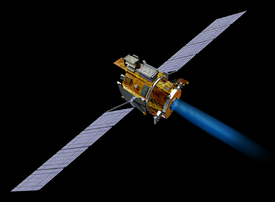
Artist concept of Deep Space 1
|
Deep Space 1 (DS1) was a NASA technology demonstration spacecraft which flew by an asteroid and a comet. It was part of the New Millennium Program, dedicated to testing advanced technologies.
Launched on 24 October 1998, the Deep Space 1 spacecraft carried out a flyby of asteroid 9969 Braille, which was its primary science target. The mission was extended twice to include an encounter with comet 19P/Borrelly and further engineering testing. Problems during its initial stages and with its star tracker led to repeated changes in mission configuration. While the flyby of the asteroid was a partial success, the encounter with the comet retrieved valuable information. Three of twelve technologies on board had to work within a few minutes of separation from the carrier rocket for the mission to continue.
The Deep Space series was continued by the Deep Space 2 probes, which were launched in January 1999 piggybacked on the Mars Polar Lander and were intended to strike the surface of Mars (though contact was lost and the mission failed). Deep Space 1 was the first NASA spacecraft to use ion propulsion rather than the traditional chemical-powered rockets.
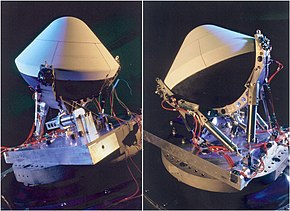
DS2 probe with heatshield and mounting
|
The polar lander (falcon deep impact) was in part the inspiration for the Mars Phoenix:
Our jazzy logo cleverly unites all the elements of our mission: the planet Mars, water, and fire. The Mars image in the background shows the northern polar cap and just to the left, still inside the arctic circle, a droplet of water swirls out into space from our landing site. Superimposed on the water is the fiery Phoenix bird scanning the Universe with a hunter�s eye. Clearly, the Phoenix is searching for something.
Remember the history of the mythical Phoenix. Throughout its 500-year life span it brings good fortune to those that see it. But as it finally ages and dies, it bursts into flames. A new Phoenix is reborn from the ashes of the old and thus continues for another 500 years. It is a popular myth throughout the world.
This is an apt symbol for the Phoenix mission that is built on the heritage of the Mars Polar Lander and the 2001 lander. When MPL was lost while landing on the southern polar layered terrain in 1999, the 2001 lander mission was canceled even though it was four months into its final assembly and test phase. The Phoenix mission has kept its costs low by leveraging the investments that NASA made in those two mission. We actually have launched the original 2001 lander, with a multitude of improvements and a new instrument suite, toward Mars on Aug. 4, 2007. Landing will take place on May 25, 2008, at approximately 4:30 p.m. PDT. Appropriately, this is Memorial Day.
NASA�s overall goal for the exploration of Mars follows the overarching theme: follow the water. Water shapes the planet by carving canyons and forming ice caps and perhaps glaciers. It is transported through the atmosphere affecting the climate that changes over the eons in response to orbital variations. When astronauts arrive on Mars, a source of water will be of prime importance. Finally, unfrozen water is the basis for life and the ingredients necessary for its genesis and growth. Truly, it is the holy grail of our exploration of the red planet.
https://mars.nasa.gov/programmissions/missions/past/phoenix/
The Mars Phoenix logo resembles a phoenix in the underworld of Mars (deep space 2)
The Mars Phoenix would have launched in 2001 had the Falcon/Deep Space 2 not impacted Mars at such a "high velocity"...Mars Polar Lander Deep Space 2 failure was a falcon deep impact success giving birth to the Phoenix and InSight/SEIS/RISE....
The 2001 Mars mission was instead the monolith:
The Mars Surveyor 2001 project was a multi-part Mars exploration mission intended as a follow-up to Mars Surveyor 1998. After the two probes of the 1998 project, Mars Climate Orbiter and Mars Polar Lander, were both lost, NASA's "better, faster, cheaper" exploration philosophy was re-evaluated, with a particular eye on the two 2001 project probes. As a result, the Mars Surveyor 2001 Lander was canceled in May 2000, but the decision was made to go ahead with its orbiter counterpart. The Mars Surveyor 2001 Orbiter, renamed 2001 Mars Odyssey, was launched April 7, 2001 reached Mars on October 24, 2001.
Later, the lander spacecraft was adapted[2] to be used in the Mars Phoenix Lander which landed successfully on Mars in 2008.
Deep Space 2/polar lander inspired the Phoenix lander
InSight is based on the Phoenix lander
All 3 missions are about Mars underground....
Indeed (as depicted by BBC) InSight is a Mars Phoenix rising!

" Phoenix has indeed arisen, but now as InSight. We're going back to Mars."
http://www.bbc.com/news/science-environment-19332086
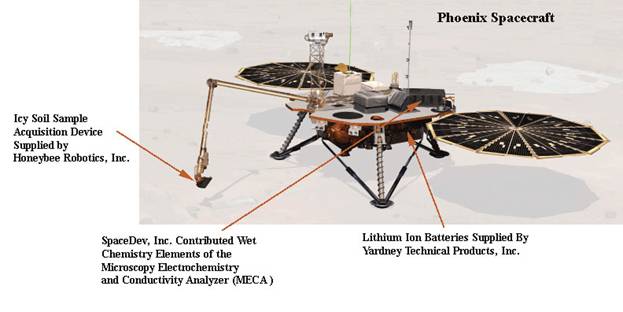
Engineers know the capabilities and limits of the Phoenix lander system, which was originally designed for a mission that was supposed to launch in 2001. The 2001 lander, named Surveyor, was canceled in the wake of the back-to-back failures of NASA’s Mars Climate Orbiter and Mars Polar Lander missions in 1998.
Keep in mind the Martian south pole "falcon" impact Deep Space 2 was 4 months after the Shoemaker south pole moon crater impact/Deep Space 1 impact:

Lunar Prospector is the third mission selected by NASA for full development and construction as part of the Discovery Program. At a cost of $62.8 million, the 19-month mission was designed for a low polar orbit investigation of the Moon, including mapping of surface composition and possible polar ice deposits, measurements of magnetic and gravity fields, and study of lunar outgassing events. The mission ended July 31, 1999, when the orbiter was deliberately crashed into a crater near the lunar south pole after the presence of water ice was successfully detected.
The probe also carried a small amount of the remains of Dr. Eugene Shoemaker (April 28, 1928 – July 18, 1997), astronomer and co-discoverer of Comet Shoemaker-Levy 9, to the Moon for a space burial.

The Mars Polar Lander, also known as the Mars Surveyor '98 Lander, was a 290-kilogram robotic spacecraft lander launched by NASA on January 3, 1999 to study the soil and climate of Planum Australe, a region near the south pole on Mars. It formed part of the Mars Surveyor '98 mission. On December 3, 1999, however, after the descent phase was expected to be complete, the lander failed to reestablish communication with Earth. A post-mortem analysis determined the most likely cause of the mishap was premature termination of the engine firing prior to the lander touching the surface, causing it to strike the planet at a high velocity.[1]
Detailed information about Braille comes primarily from the Deep Space 1 probe, which passed within 26 km of the asteroid on July 29, 1999,[13]
The spacecraft wasn't expected to survive the landing but its instruments remained operational, leading to yet another milestone. "This is the first gamma-ray experiment that has ever been done on the surface of a body other than Earth," said Dr. Jacob Trombka of NASA's Goddard Space Flight Center. "In fact, we can say it's the first feasibility study of how to design an instrument to be used on a rover that could select samples from the surface, look for the presence of water, or map the surface for the purpose of future mining."http://solarsystem.nasa.gov/planets/433eros/indepth
Between December 1999 and February 2001 NEAR Shoemaker used its gamma-ray spectrometer to detect gamma-ray bursts as part of the InterPlanetary Network.
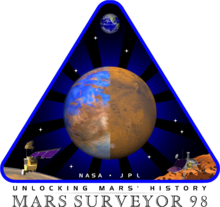

Deep Space 1 (DS1) was a NASA technology demonstration spacecraft which flew by an asteroid and a comet. It was part of the New Millennium Program, dedicated to testing advanced technologies.
Launched on 24 October 1998, the Deep Space 1 spacecraft carried out a flyby of asteroid 9969 Braille, which was its primary science target. The Mars Polar Lander, also known as the Mars Surveyor '98 Lander, was a 290-kilogram robotic spacecraft lander launched by NASA on January 3, 1999 to study the soil and climate of Planum Australe, a region near the south pole on Mars. It formed part of the Mars Surveyor '98 mission.
The Mars Polar Lander carried two small, identical impactor probes known as "Deep Space 2 A and B". The probes were intended to strike the surface with a high velocity at approximately 73°S 210°W, to penetrate the Martian soil, and study the subsurface composition up to a meter in depth. However, after entering the Martian atmosphere, attempts to contact the probes failed.[2]
Deep Impact (1998)
Resonating "Deep Impact"="Falcon Impact" (Osiris/seismic fenix underground rising as Horus)
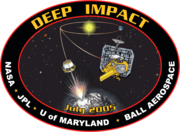
The Hayabusa (Japanese for “Peregrine Falcon”)
The Peregrine Falcon, also known as the "Horus Falcon" or "Horus Hawk," was associated with the gods Horus and Ra.
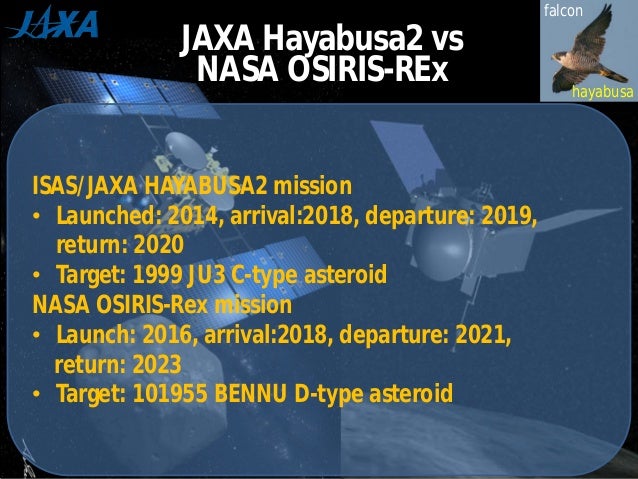
OSIRIS REx = Mars InSight=Falcon 2018 impact/rise

Osiris Insight is Mars Deep Impact 2018 via Deep Space 1&2.....
List of asteroid missions:
NEAR-Shoemaker (NASA mission)
Hayabusa (JAXA mission)
Dawn (NASA mission)
Hayabusa2 (JAXA mission)
OSIRIS-REx
http://www.psrd.hawaii.edu/CosmoSparks/Oct16/PSRD-asteroids-upclose.pdf
These 5 impact missions collectively represent the Phoenix underground, Horus, Rise, Osiris....
The OSIRIS-REx team began the Egyptian theme with a mission acronym that spells the name of an Egyptian diety: Origins Spectral Interpretation Resource Identification Security Regolith EXplorer. The asteroid’s new name, Bennu, comes from an Egyptian god usually depicted as a heron, which OSIRIS-REx will resemble as it extends its sampling probe to the asteroid’s surface. That resemblance was noticed by nine-year-old Michael Puzio, who won a contest to name the asteroid. Chesley proposes to continue the Egyptian them with ISIS: Impactor for Surface and Interior Science. I think a safe prediction is that the features identified on Bennu will also follow an Egyptian theme.http://futureplanets.blogspot.ca/2013_05_01_archive.html
The primordial Bennu (heron) is also related to the falcon landing...

It was said that after the world was created, Horus landed on a perch, known as the djeba, which literally translates as finger, in order to rest, which consequently became considered sacred. On some occasions, Horus was referred to as lord of the djeba (i.e. lord of the perch or lord of the finger), a form in which he was especially worshipped at Buto, known as Djebauti, meaning (ones) of the djeba (the reason for the plural is not understood, and may just have been a result of Epenthesis, or Paragoge). The form of Djebauti eventually became depicted as an heron, nevertheless continuing to rest on the sacred perch.http://ancientegypt.wikia.com/wiki/Horus
According to Egyptian mythology, the Bennu was a self-created being said to have played a role in the creation of the world. It was said to be the ba of Ra and enabled the creative actions of Atum.[1] It was said to have flown over the waters of Nun that existed before creation, landing on a rock and issuing a call that determined the nature of creation. It was also a symbol of rebirth and was therefore associated with Osiris.[2]
https://en.wikipedia.org/wiki/List_of_geological_features_on_433_Eros
List of geological features on asteroids:
https://en.wikipedia.org/wiki/Lists_of_geological_features_of_the_Solar_System#Asteroids
Lunar Prospector=Moon Monolith
Galileo=Jupiter Monolith
Although the impacts took place on the side of Jupiter hidden from Earth, Galileo, then at a distance of 1.6 AU from the planet, was able to see the impacts as they occurred. Jupiter's rapid rotation brought the impact sites into view for terrestrial observers a few minutes after the collisions.[15]Making this article interesting...
The article goes on to show a photo comparison of Galileo/Lunar Prospector...
Galileo also fits the deep space theme....
On October 29, 1991, two months after entering the asteroid belt, Galileo performed the first asteroid encounter by a human spacecraft, passing approximately 1,600 kilometers (990 mi) from 951 Gaspra at a relative speed of about 8 kilometers per second (5.0 mi/s).
| Washington Territory | |
| Admission to Union | November 11, 1889 (42nd) |
|---|

STS-34 was a NASA Space Shuttle mission using Atlantis. It was the 31st shuttle mission overall, and the fifth flight for Atlantis.[1] STS-34 launched from Kennedy Space Center, Florida, on 18 October 1989, and landed at Edwards Air Force Base, California, on 23 October. During the mission, the Jupiter-bound Galileo probe was deployed into space.
Atlantis launched the first spacecraft to encounter an asteroid resonating Armageddon.












No comments:
Post a Comment